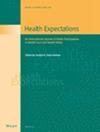Listening to Women's Voices: A Patient and Public Involvement Exercise Exploring Vulval Reconstructive Surgery for UK Women With Female Genital Mutilation (FGM)
Abstract
Introduction
This article presents patient and public involvement and engagement (PPIE) work undertaken to explore FGM survivors' and stakeholders' views on reconstructive surgery, potential service models, care pathways, barriers to access and other support needs. The aim was to set research priorities, identify key themes and help inform subsequent research in the field.
Methods
A national research collective was established comprising over 20 stakeholders, including FGM survivors/women with lived experience, healthcare professionals, academics and advocacy groups. The group undertook two discussion workshops with FGM survivors (n = 11 participants), two national stakeholder events (n = 142 attendees) and significant advocacy and partnership-building activities.
Results
Key insights were that FGM survivors would value reconstructive surgery to address body image concerns, genital pain and sexual difficulties. Potential barriers to surgery included stigma, safeguarding concerns, lack of awareness and fear. Significant gaps were identified around women's knowledge of clitoral anatomy, FGM types and specialist services. Survivors and stakeholders emphasised the need to complement surgical reconstruction with a comprehensive care pathway including trauma counselling and psychosexual therapy.
Conclusion
This study highlights the importance of a survivor-led approach to FGM service development, as often the voices of FGM survivors are not included. The exercise demonstrated that, with the right approach, it is possible to engage ‘minoritised communities/individuals from the global majority’ and communities dispayed considerable willingness to participate in this sensitive research field. It also emphasises an urgent need for accessible, high-quality FGM care informed by the voices of those affected, to improve outcomes and support for FGM survivors in the United Kingdom.
Patient or Public Contribution
Women with lived experience of FGM and women from FGM-affected communities, as well as other national stakeholders (including Non Government Organisation's and charities working with FGM survivors, academics, artists and campaigners were involved in the design and conduct of this study, analysis and interpretation of the data and preparation of the manuscript.


 求助内容:
求助内容: 应助结果提醒方式:
应助结果提醒方式:


